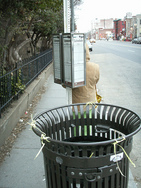WMATA budget deep dive, part 2: Bus service cuts
In addition to the $15 million of rail service cuts discussed in part 1, WMATA’s proposed FY2011 budget targets bus service for net cost recductions of $18 million.
It lists a pool of bus service reductions (pages 19-21) that total about $31 million in costs, or $26.5 million after factoring in ridership losses.
Metrobus ridership has dropped much more than rail ridership, mainly in the District of Columbia. The drop is closely correlated with unemployment of blue collar workers.
In addition, a 2007 WMATA survey showed that one in five Metrobus riders own no automobile and that Metrobus riders have a much lower income than Metrorail riders. The ability of workers to access jobs is closely tied to economic recovery and service reductions should be viewed in this light.
WMATA has analyzed their service and proposed reductions which they believe least impact service. Like the proposed rail service cuts, the cuts fall into three groups:
Group 1: Service reductions that do not impact span of service or service area and have minimal impact on ridership but may inconvenience passengers.
These would include increasing bus stop spacing, replacing weekday service on four holidays (Presidents Day, Columbus Day, Veterans Day & Martin Luther King Day) with supplemented Saturday service and running this same service on four other seasonal days such as the day after Thanksgiving. WMATA estimates a loss of fare revenue of $0.6 million with net “subsidy savings” of $3.7 million.
This category would also include service reductions that impact headways (waiting time) and targeted trips without significant loss of ridership. Those reductions would lose a projected $93,000 in fare revenue with “subsidy savings” of $0.5 million.
The total subsidy savings from this group of service reductions total about $4.2 million.
WMATA may be overestimating the ridership loss in this group since they include revenue loss from spacing out bus stops on some bus lines to 1 every 0.2 miles (from the current 1 per 0.13 miles). Such a move will not likely affect ridership, has not done so in other cities and may actually increase ridership due to higher average bus speed.
They also apply a standard formula to estimate the loss of ridership by the reduction in revenue hours that likely overestimates the ridership loss from a reduction in service on the “minor” holidays and holiday-related days. Since WMATA currently runs weekday service on these days, there is an overabundance of service with many buses running near empty in the peak periods—a factor which will skew ridership loss in a revenue hours formula.
Group 2: Headway widening, route segment elimination, elimination of segments that overlap with local service, route consolidations, route eliminations and late night service elimination that has a significant impact on ridership or span of service. This group also includes some minor service improvements that would increase costs.
Examples of bus cuts in this group are eliminating the 18E/F, truncating the 42 at McPherson Square instead of 9th & G Streetss and headway widening on lines like the L1/2 and the H8. It also includes discontinuing Friday and Saturday late night service in Maryland & Virginia, among other proposals.
If these proposals were implemented, they would result in a revenue loss of about $0.8 million and a “subsidy savings” of $4.7 million. These proposals would generally force more transfers and make trips longer to complete. They also include some shrinking of the system geographic coverage. The elimination of late night service will impact both service workers and trips generated by night destinations.
Group 3 involves major impact to ridership and economic activity. It includes complete route elimination on 14 different lines.
These cuts include ending late night bus service on Friday and Saturday in the District, terminating the 38B at Washington Circle instead of Farragut, eliminating off-peak service on the C8, cutting back the P17/18/19 at Southern Ave instead of continuing to downtown DC, widening the 16G headways to 15 minutes in peak period and 30 minutes off-peak, and widening peak period headways on the 70 line, among others.
If these proposals were implemented, they would result in a revenue loss of about $3.1 million and a “subsidy savings” of about $17.5 million. The impacts are widespread and affect commuters to the District, blue collar service workers, college students and activity generated by night destinations. These create major service degradations.
If all proposed bus service cutbacks outlined in the public document were implemented, WMATA estimates it would lose 5.8 million passenger trips on an annual basis.
| Group | Impact | Cost reduction | Lost fare revenue | Net savings | Annual psgr. loss |
|---|---|---|---|---|---|
| 1 | Minimal ridership loss, riders inconvenienced | $5.00 | $0.70 | $4.20 | 935,000 |
| 2 | Moderate ridership loss or impact on span of service | $5.50 | $0.80 | $4.70 | 1,026,000 |
| 3 | Significant ridership loss, significant econ. impact | $20.65 | $3.10 | $17.56 | 3,874,000 |
A great percentage of these losses in passenger trips will impact citizens that can least afford it. The 2007 WMATA survey showed that Metrobus riders are more minority, female, lower income and without automobiles than Metrorail riders.
We can’t underestimate the magnitude and impact of the cuts in groups 2 and 3. They considerably reduce the service area, operating hours and headways of the Metrobus system. Coupled with proposed rail reductions and fare increases, they will substantially diminish public transportation in the Washington metropolitan area, if implemented. I’ll look at alternatives in future posts.
Next up: fares.

